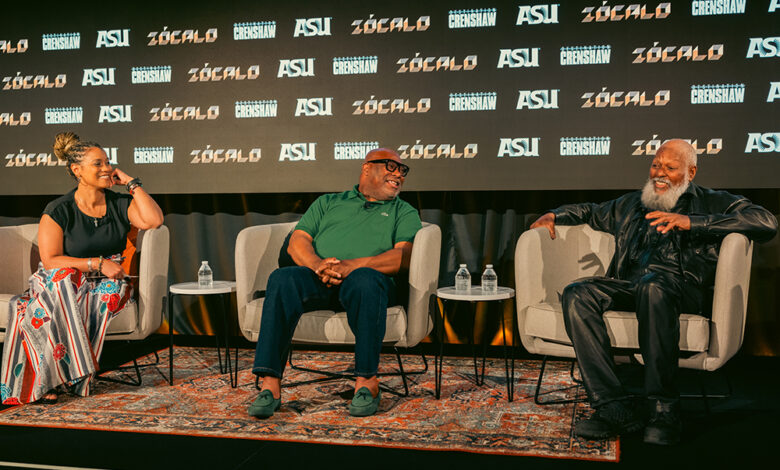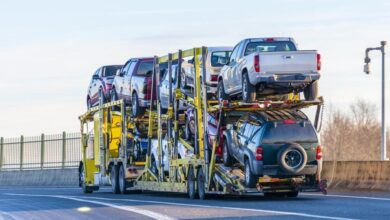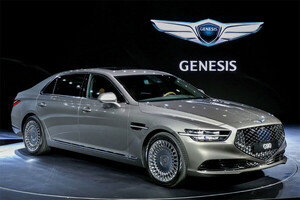What If We Saw Cars Like Rolling Sculptures?

Where Crenshaw and Leimert boulevards meet, the silver glint of artist and sculptor Charles Dickson’s “Car Culture” is beginning to take shape. One of Dickson’s largest public artworks to date, the towering sculpture, a celebration of Black innovation and expression, is part of Destination Crenshaw, a new 1.3-mile, open-air monument to Black Los Angeles.
A smaller model of Dickson’s sculpture made its way to the ASU Herald Examiner Building on 11th and Broadway last week, to go on view during the Zócalo and Destination Crenshaw public program “Is Car Culture the Ultimate Act of Community in Crenshaw?”
The project’s director of public art programs Heather Heslup and lead historian Larry Earl joined Dickson for the conversation, which touched upon the storied history of Black Angelenos and their automobiles, and why the car continues to represent a beacon of freedom and mobility for the Crenshaw community today.
Earl offered an overview of the car’s significance for Black L.A., citing the work of his friend, the historian Alison Rose Jefferson, author of Living the California Dream: African American Leisure Sites during the Jim Crow Era. Jefferson’s family personally experienced the power of the automobile driving to Los Angeles from the Jim Crow South during the Great Migration. “The car is an essential aspect of the migration,” Earl said.
Once families like Jefferson’s made it to L.A., Earl said, the car became synonymous with economic uplift and leisure, as it allowed people to drive downtown for work, or to the beach for pleasure. The mid-century rise of the custom car—as people started to use the vehicles as a vehicle for self-expression, showing off their artistry and engineering prowess—launched the cruising scene down Crenshaw on Sundays, he added. People could show off their personalized lowriders, and share how they’d tricked them out. Car clubs, and a deeper communal culture, came next. (“You know we like a coordinated outfit,” Earl quipped to audience laughter, referring to the clothes car club members wear.)
Cars allow anyone ‘to be the sculptor, to be the painter, to be the technologist.’
Dickson said that he has always been struck by the possibilities of expression and empowerment that cars represent. “When I went to teach at grade schools, I’d always tell them that the automobile is a rolling sculpture,” he said.
If you think about it, the artist continued, cars allow anyone “to be the sculptor, to be the painter, to be the technologist.” They’re also something, Dickson added, that brings together different cultures. “The Latino culture has certain kinds of paint,” he said. “You can leave it to the brothers to have big, giant wheels. Texas, they have extensions on their wheels that come out this far,” Dickson said, widening his arms.
Dickson said that he took all of this into account with his design for “Car Culture.” Six-and-a-half years in the making, the stainless steel sculpture showcases figures inspired by the West African Senufo culture, who are adorned with a crown of vintage cars. Dickson positioned a futuristic “Star Trek”-like engine, replete with a crystal, on the very top of the sculpture. Tying all of these elements together is a fiber optic cable which, Dickson said, represents the connection between these forces of “motorized possibilities.”
“Car Culture” is currently being installed at Destination Crenshaw’s Sankofa Park. Heslup drew a connection between the concept of Sankofa, an Adrinka symbol that translates to “return to your past,” and Dickson’s work.
“I think that your process and practice embody the idea of Sankofa Park,” Heslup said. She nodded to the loss of giants of the Black L.A. art scene, like John Outterbridge and Charles White, who were themselves mentors to Dickson. “You hold on and carry elements of them into your work now,” said Heslup.
During audience questions, one person asked what the panel hopes historians will say about Destination Crenshaw 100 years from now. “That Black folks and their allies got together to stamp a space that was so unique that it provided a model for the entire world,” said Earl.
Another asked Dickson what it was like to see the first part of his sculpture installed last month at Sankofa Park. “I’ve done a lot of public art things, but I think it’s pretty much the pinnacle of what I’ve done so far,” he said.
And finally, someone asked how one might become a Destination Crenshaw artist without having a resume like Charles Dickson’s.
Our intention is to engage artists from all levels, Heslup answered, noting that artists can apply now for consideration to be part of the project through Destination Crenshaw’s “RFQ” (Request for Qualifications) system online.



